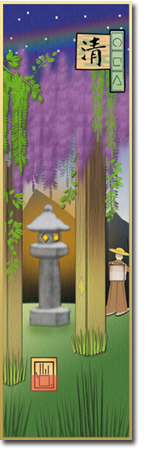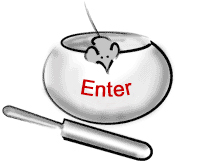On The Way: The Daily Zen Journal
Harmony – Part 3
Zhi Yi (538-597)
Now we must talk about what to do while sitting in Zen meditation. The same three things must be attended to. In one sitting, whether the time is long or short, i.e., within a twelve-hour period whether it lasts for one, two, or three hours, when using one’s heart-mind to regulate thoughts, one must know well during this time whether or not to harmonize body, breath, and heart.
Thus, when you are sitting, when you seek to regulate the body according to its present condition, seeing how it is at this moment, whether too loose or too tight, leaning or bent, head held too low or too high, you feel that accordingly, you should straighten up. Each time you do this it brings peace and tranquility, so that during the meditation you are neither too slack nor too tight. Then, indeed, you are balanced and straight, truly settled in your meditation.
Then on your next occasion, it may be that while you are sitting, you try to regulate the body harmoniously, but the Qi breath does not respond to directions. In the case where the Qi breath cannot be regulated, then you must follow the practical directions given below:
If you wish to regulate the heart-mind, there are three techniques that you must rely on. The first is to focus your attention on the lower part of the abdomen three inches or so below the navel, two or three inches within, the center of gravity of the body.
Second, you must relax the body entirely. Third, you must visualize your breath as passing through every pore of your body, going out and entering every joint and crevice, so that there are no obstacles to its even flow.
If you purify the heart-mind and make the breath quiet and hardly perceptible, then when the breathing is thus regulated, worries and anxieties will not arise, and the mind will be easily focused and settled.
When the breath is noisy (windy) or uneven (sighing), the breathing is too quick, the body overburdened, you can use the above-mentioned methods to regulate yourself. Whenever you use this Dao of breathing, notice how finely the breath spins forth, barely perceptible.
Then the next time you meditate, even though the body and breath are harmonized, the mind sometimes remains either too deep or too shallow, too loose or too tight, and doesn’t respond. At such a time, if you aspire to awakening, you must use the above methods to regulate yourself suitably while meditating.
At this point visualize an imaginary object at the tip of your nose, and bring the mind back to become aware of it, not letting yourself be distracted by random images. This will control the mind from sinking too deep.
At this time it is easy to quell the heart-mind by focusing attention down into the lower abdomen and make it an object of vision. You thus control all random thoughts, keeping your mind settled in Zen concentration. In this way, your heart is serene and tranquil.
There is no before and after in regulating these three faculties. Even though they are not regulated in one occasion, they can be regulated suitably during the next Zen sitting. As for properly harmonizing the body with the breath and heart-mind, there are no other shared vehicles for keeping them together in harmony other than the methods explained above.
If you can blend them together so they are regulated as one harmonious unit, then you can get rid of all your impediments and worries, and keep all obstacles from arising. At last, you will be able to master the way of Zen meditation.
Finally, there are directions for coming out of meditation.
“When coming out of Zen, regulate the three activities for being human.”
When coming out of the realm of Zen meditation, you must first of all free the mind from its state of concentration and think about other things. Open the mouth, exhale, and visualize the breath as passing through all of the pores and joints of the body, freely released into the outer world. Then slowly and gently move your body, shoulders, hands, head, and neck. Following this, move the feet and legs, until the muscles are soft and pliable.
Next, use your hands to massage the pores of the skin on the body. Rub the palms of the hands together until they feel warm, and press them gently to the eyelids, and then open them. Only after the heat of the body generated during meditation is dissipated should you try to stand up and freely leave the meditation area.
If you don’t follow these rules, even if when sitting you have attained mastery of the heart, if you leave the meditation too quickly by force, then the refined Dharma way will not yet be gone but will remain inside your body (i.e., the transition to the coarse way of the outer world not yet completed).
The method for regulating the body, the breath, and the heart-mind is to pass from the refined to the coarse state. This process is called “The proper way to enter, abide in, and come forth from Zen meditation.”
As a Gatha hymn puts it:
Proceeding and pausing have their own order,
The coarse and the refined are not to be rivals;
As in the case of a well-trained horse, which
When spurred gallops, when reigned halts.
The Lotus Sutra says:
All the great multitude, all Bodhisattvas
For measureless innumerable millions of kalpas,
For the sake of the Buddha path,
Perform diligent service with devotion and care.
Enter, abide, and come forth from meditation well.
Chih I (538-597)
source Zen is for Everyone- The Xiao Zhi Guan Text by Zhi Yi – translated by Michael Saso 2000





Now we must talk about what to do while sitting in Zen meditation.
Like so many of the early teachers of Zen and meditation, there is an outline of preparing oneself for meditation, but there is seldom too much direction about what exactly it IS you are entering into. Which is not a bad thing, as it allows us the freedom to explore meditation for ourselves. The most common theme is following the breath, then at some point just the awareness remains.
There are plenty of distractions that arise and like riding a runaway horse, we attempt to rein the mind gently back into the present. The best tools and the ones that are common to almost all techniques are awareness of breath and posture. The constant presence of both of these allows us to practice anywhere, in any circumstance.
Fixing the posture in some schools amounts to a gentle rocking from side to side to find center and back and forth until one senses the alignment that is just right. Coming out of meditation can be a simple reversal of that process. The one point to question is whether we really want to leave all that awareness or “refined Dharma” on the cushion. It would seem to me, that part of the goal-less goal is to carry that state of being forward with us into the relative world.
Finding a way to continue our meditation in daily life is a lifetime study.
Carrying on,
Elana, Scribe for Daily Zen